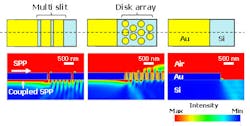Low-loss waveguide for surface-plasmon polaritons may help drastically shrink integrated photonics
Researchers at Toyohashi University of Technology (Toyohashi Tech; Toyohashi, Japan) have developed a simple, low-loss waveguide for surface-plasmon polaritons (SPPs) that is applicable to nanoscale photonic integrated circuits on silicon.1 Components such as these waveguides will be essential in shrinking the size of silicon photonic circuits by using SPPs in place of freely propogating light in certain portions of the circuits.
Surface plasmon polaritons (SPPs) are waves that propagate along the surface of a conductor; they are collective oscillations of electrons coupled with the optical field at the nanoscale beyond the diffraction limit of propagating light waves. There has been increasing interest in SPPs as signal carriers in nanoscale integrated circuits to decrease component size and reduce power consumption. However, low-loss SPP waveguides with detectors had not previously been developed for use in nanoscale optical integrated circuits.
Now, Mitsuo Fukuda and his group at Toyohashi Tech have developed a simple, low-loss waveguide for SPPs that is applicable to nanoscale integrated circuits.
A thin metal film deposited on a silicon substrate was terminated with a diffraction structure (a multi-slit or a metal disk array) at its end to guide the SPPs transmitted on the surface (air-metal interface) to the opposite side of the metal (metal-silicon interface). A Schottky barrier is formed at the metal-silicon interface, and the free electrons in the metal are excited by the guided SPPs and then cross over the barrier. The overflowing electrons result in observable photocurrents.
The waveguide developed in this research enabled the efficient propagation of SSPs in 1550-nm-wavelength bands (transparent to silicon) along the gold film surface, and the photocurrents were much larger than for waveguides without the diffraction structure (26 times for the grating structure and 10 times for the disk array).
Source: http://www.tut.ac.jp/english/newsletter/research_highlights/research02.html
REFERENCE:
1. M. Fukuhara et al., Applied Physics Letters, 104, 081111 (2014); doi: 10.1063/1.4866792

John Wallace | Senior Technical Editor (1998-2022)
John Wallace was with Laser Focus World for nearly 25 years, retiring in late June 2022. He obtained a bachelor's degree in mechanical engineering and physics at Rutgers University and a master's in optical engineering at the University of Rochester. Before becoming an editor, John worked as an engineer at RCA, Exxon, Eastman Kodak, and GCA Corporation.
